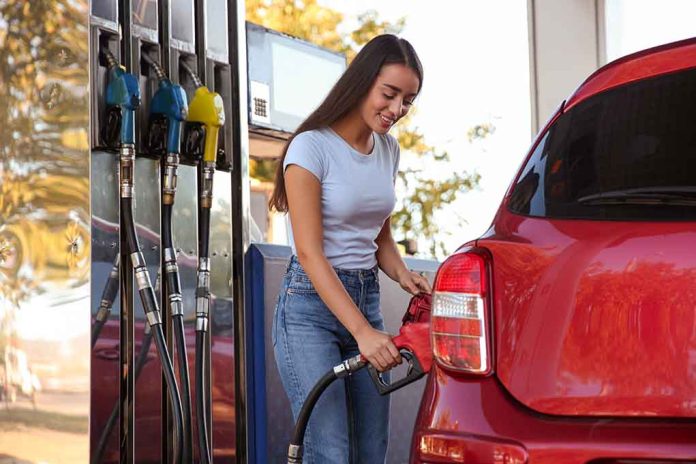
(DailyVibe.com) – Gasoline prices are often a major topic of conversation when cost of living comes up. Many people need to use gas to be able to work, but rising costs can hit hard. Blame is laid either on supply and demand, politicians, social unrest and wars, or greedy oil corporations — all depending on to whom you’re speaking. Still, no matter what is behind prices when they rise, most people who are dependent on gas have to find ways to actually afford it.
If bringing down the cost per mile is the goal, there are certainly ways to do that. While buying a vehicle with a better fuel efficiency rating may be an option for some, simply buying a new vehicle isn’t in everyone’s budget, especially since the cost of cars has also risen exponentially. Still, anyone can reduce their gas usage by a dollar or more per gallon by creating some new habits.
Check Your Tire Pressure
Even good tires deflate over time, and when your tires are not properly inflated your gas tank suffers. Your tire pressure is measured in pounds per square inch, also known as PSI. You can check your tire pressure with a pressure gauge, and it will give you the PSI. On the inside of your car door is a sticker, and that sticker will tell you how much pressure should be in your tires. According to AAA, you should be checking your tires about monthly.
For each pound of pressure that you go below that recommended PSI, your gas mileage can be impacted by 0.2 percent. That may seem like a very low number, but over time, it absolutely adds up (not to mention wastes your money!). Plus, tires are also more expensive than ever to replace, and driving on underinflated tires can limit their use over time as well.
Take it Easy Behind the Wheel
Revving the engine may be fun, but you might be surprised how much you’re paying for it. Making your engine work harder than it has to will work against you and your wallet. This includes rapidly accelerating, sudden braking, speeding, and even high-speed driving (even where legal).
In fact, an experiment done by Edmunds with a sedan, SUV and truck showed that calmer drivers increased their fuel savings by 33 to 38 percent. So, taking it easier isn’t only safer, but it keeps more money in your own pocket.
Rewards Programs
Gasoline rewards programs are gaining in popularity. While not all gas stations have a program, many do. Grocery stores and convenience stores often will offer their own gas station or partner with a local gas station to offer incentives in the way of free gas discounts, and signing up is usually free.
When you make a purchase of gas, groceries, or other items, you accumulate points or cents off. While this is often a “use it or lose it” arrangement within a period of time, such as a month or a quarter, rewards programs can save you a lot of money when you fill up at the pump.
Plan Your Drive
Finding the most cost efficient route is easier than ever. While it used to involve road maps and a few guesses, traveling with apps at our disposal has made traveling or commuting easier than ever.
Google Maps, for instance, can give a driver multiple routes to get to a destination, showing possible shortcuts that take time or miles off your trip. GPS apps like Waze can show you where the traffic is backed up, so that you don’t get stuck idling or in a bumper to bumper situation.
While the shortest route is ideal, good planning also requires thinking about which routes could leave you sitting and waiting, which could potentially use more gas than if you took the route that was five miles more.
About Idling
Idling in traffic, at lights, and during a backup is sometimes unavoidable. If you have a newer car, it may be more cost effective when sitting in traffic to turn your car off while waiting, as newer cars only use about 10 seconds worth of gas to start. Older cars may not be as efficient and, of course, the wear and tear of turning it on and off repeatedly may be excessive.
Newer cars don’t usually need “warm up” time the way that older cars did in cold weather, and the heat will get warmer faster if you drive it rather than waste time and fuel idling and waiting for it.
Even if you are waiting to pick someone up or for your partner to run into the house, it will save gas to just turn off the car.
Motor Oil Matters
Engine friction causes higher gasoline usage. Your oil reduces the friction in your engine. So, not only is oil important for the life of your engine, but also for your gas mileage.
Your car’s engine manufacturer has specific oil requirements and specifications, and if you’re purchasing your own oil, Edmunds recommends making sure that the oil you choose meets those guidelines.
Oil changes, including replacing the filter, should also be done as recommended by your car’s manual. Taking care of your motor and choosing energy conserving oil can help save gas by one to two percent. Again, it may seem like a small improvement, but over time and with other strategies, it truly adds up.
Keep Your Engine Running Smooth
While most newer cars don’t require constant tune-ups like older vehicles did, keeping your car serviced as recommended by your manual or manufacturer can make a difference not only to the life of your car, but to your fuel prices as well.
Cars today have all sorts of computer sensors, and while many of them will not not make your car stop working when they start to fail, they can absolutely impact your fuel usage well before you have to call that tow truck. Older spark plugs, filters and similar basics can impact up to around four percent of your efficiency, but something like a bad oxygen sensor might be eating up as much as 40 percent of your gas mileage.
Check your manual for how often you should have these things looked at, and keep in mind that simply having your mechanic hook up a computer to your car can give you a lot of actionable information.
Don’t Get Weighed Down
Each 100 pounds of stuff you put in your car adds a one percent drain on your gas mileage. A spare or a donut spare, a container of ice melt or kitty litter, tools, and other things add up quickly. Consider what you need in order to be safe in an emergency, of course, but if you’ve been driving around with your thrift store donations for a month or three, you may want to consider dropping them off to get better fuel economy.
Extra Cargo Doesn’t Help the Car Go
Have you ever seen those cool car tests on commercials where they show the wind blowing around the vehicle to show how the air blows around it? That’s called aerodynamics. Good aerodynamics help the engine not have to work as hard. The less wind resistance your car has, the better it runs and the more efficient it will be with, you guessed it, gasoline.
Placing those boxy-looking cargo holds or bicycles on your car roof really interrupts your car’s aerodynamic function, and really eats away at your gas mileage.
The US Department of Energy has studied this, and has reported that rooftop cargo boxes “can reduce fuel economy by around 2% to 8% in city driving, 6% to 17% on the highway, and 10% to 25% at Interstate speeds (65 mph to 75 mph).”
Those are staggering statistics. Now, if you really need one for a reason, consider removing it when you aren’t using it, or try a rear-mount cargo hold instead. They only reduce your efficiency by a max of about five percent on the highway and even less in town or the city.
Spend Less Time Behind the Wheel
This is a no-brainer, right? Try to dive less. While this isn’t going to be accessible for everyone, consider other options to driving if you can. Carpooling, public transportation, walking, and biking are all not only good for the environment, they can often lead to a healthier lifestyle for people who have the privilege of being able to choose these alternatives. You can save money, gas, and get your body moving all at once.
Use public transportation. Take out your BMX from the garage. Get into a carpool arrangement for going to work, especially with someone who owns an electric vehicle (it’s good for the environment). If the car doesn’t leave the driveway often, the gas tank doesn’t need to be filled often either.
After putting all, or even some, of these strategies into action, you may question if you are indeed saving money on gas. Newer cars will let you set your mileage and your gas usage on a tip right in the odometer. If you aren’t sure if your car will display this information, check your manual. If your car doesn’t have this feature, you can keep a log of how many miles you have driven and when/how much gas you have used. Simply divide to get your miles per gallon and see how much your gas mileage improves.
Copyright 2023, DailyVibe.com
















